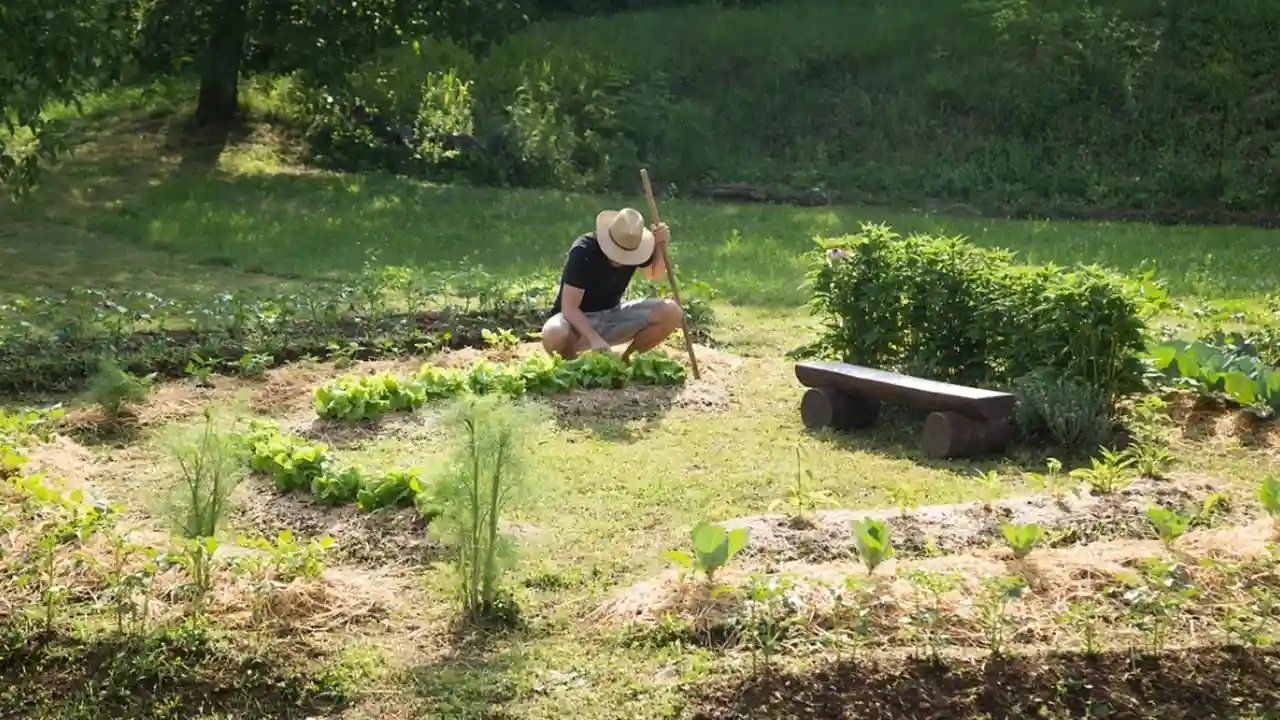Dealing with Aphids 4 Natural Remedies
Construct a basic greenhouse with these 3 simple designs. Extend your growing season and protect plants.

Building a Greenhouse for Beginners 3 Simple Designs
Welcome, aspiring green thumbs! Dreaming of fresh tomatoes in winter or starting your seedlings early? A greenhouse is your secret weapon. It’s not just for commercial growers; even as a beginner, you can build a functional and affordable greenhouse right in your backyard. This guide will walk you through three simple designs, perfect for extending your growing season, protecting delicate plants, and experimenting with new crops. We'll cover everything from choosing the right spot to selecting materials and even recommend some specific products to get you started. Let's dig in!
Why Build a Greenhouse Extending Your Growing Season and Plant Protection
Before we dive into the 'how,' let's talk about the 'why.' A greenhouse offers a controlled environment that can dramatically improve your gardening success. Firstly, it extends your growing season. Imagine harvesting fresh greens in late autumn or starting your spring flowers weeks before the last frost. This is possible because a greenhouse traps solar energy, keeping the interior warmer than the outside air. Secondly, it provides excellent plant protection. Your precious seedlings will be safe from harsh winds, heavy rains, unexpected cold snaps, and even some pests. It also allows you to grow plants that might not thrive in your local climate, opening up a world of possibilities for exotic fruits or delicate ornamentals. Think of it as a mini-climate zone tailored to your plants' needs.
Choosing Your Greenhouse Location Sunlight and Accessibility Considerations
The success of your greenhouse largely depends on its location. Sunlight is paramount. Aim for a spot that receives at least six hours of direct sunlight daily, especially during the winter months when light is scarce. A south-facing orientation is often ideal in the Northern Hemisphere. Consider any obstructions like large trees or buildings that might cast shadows. Beyond sunlight, think about accessibility. You'll need easy access for watering, tending to plants, and harvesting. Proximity to a water source is a huge plus, saving you countless trips with a watering can. Also, consider electricity if you plan to use fans, heaters, or grow lights. Finally, ensure the ground is level or can be easily leveled to provide a stable foundation for your structure.
Simple Greenhouse Design 1 The Hoop House Budget Friendly and Easy
The hoop house, also known as a polytunnel, is perhaps the most beginner-friendly and cost-effective greenhouse design. It's essentially a series of hoops covered with a durable plastic film. Its simplicity makes it incredibly versatile and quick to construct. You can build a small one for a few raised beds or a larger one to walk inside. The curved shape naturally sheds snow and wind, making it quite resilient.
Materials for Your Hoop House PVC or Metal Hoops and Polyethylene Film
- Hoops: PVC pipes (Schedule 40 is recommended for durability) are popular for their affordability and ease of bending. For larger, more permanent structures, galvanized steel tubing offers superior strength and longevity.
- Covering: UV-stabilized greenhouse-grade polyethylene film is crucial. Regular plastic sheeting will degrade quickly in sunlight. Look for films with a lifespan of 4-6 years.
- Base: Treated lumber or rebar for anchoring the hoops.
- Fasteners: Clamps, screws, and possibly specialized wiggle wire and channel for a secure film attachment.
Construction Steps for a Basic Hoop House DIY Guide
- Prepare the Base: Mark out your desired dimensions. Create a rectangular base using treated lumber or by driving rebar stakes into the ground at regular intervals along the long sides.
- Install the Hoops: Bend your PVC pipes or metal tubing into arches. If using PVC, insert the ends over the rebar stakes. For metal, you might need a pipe bender or pre-bent sections. Space them evenly, typically 2-4 feet apart.
- Add a Ridge Pole: Run a straight piece of PVC or wood along the top center of the hoops, connecting them all. This adds stability and helps support the film.
- Attach the Covering: Drape your polyethylene film over the hoops, ensuring it's taut and evenly distributed. Secure it to the base frame using clamps, staples, or by burying the edges in a trench. For a more professional finish, use wiggle wire and channel along the base and end walls.
- Create End Walls and Doors: Frame out simple doors at one or both ends using wood. Cover these frames with the same polyethylene film. You can create roll-up sides for ventilation.
Recommended Products for Hoop House Construction Budget Friendly Options
- Greenhouse Film: 'Growers Supply 6 Mil 4 Year Anti-Condensate Greenhouse Film' (approx. $0.20-$0.50 per sq ft depending on width/length). This film is UV-treated and designed to prevent dripping inside.
- PVC Pipe: 'Schedule 40 PVC Pipe' (approx. $5-$15 for a 10-foot section, depending on diameter). Available at any hardware store.
- Hoop Benders: If using metal conduit, a 'Conduit Bender' (approx. $30-$60) can be useful, though many suppliers sell pre-bent hoops.
- Wiggle Wire and Channel: 'Spring Lock Wiggle Wire and Channel' (approx. $1-$2 per linear foot). This system provides a very secure and easy-to-remove attachment for the film, highly recommended for durability.
Simple Greenhouse Design 2 The Cold Frame Mini Greenhouse for Small Spaces
A cold frame is essentially a miniature, unheated greenhouse, perfect for small gardens, urban spaces, or for gardeners who want to dip their toes into season extension without a large commitment. It's a bottomless box with a transparent lid, typically angled to maximize sun exposure. Cold frames are excellent for hardening off seedlings, protecting tender plants from early frosts, or growing cool-season crops like lettuce and spinach well into winter.
Materials for Your Cold Frame Wood or Recycled Materials and Transparent Lid
- Frame: Treated lumber (cedar or redwood are naturally rot-resistant), concrete blocks, or even recycled materials like old tires or straw bales.
- Lid: Old windows, polycarbonate panels, or clear corrugated plastic sheeting. The lid should be hinged or easily removable for ventilation.
- Hardware: Hinges, screws, and possibly a prop stick to hold the lid open.
Building a Basic Cold Frame Step-by-Step Guide
- Choose Your Spot: Select a sunny, well-drained location.
- Construct the Box: Build a rectangular box with one side taller than the other to create a slope for the lid. This angle helps maximize sun exposure and sheds water. For example, the back wall could be 18 inches high and the front wall 12 inches high, with side walls connecting them.
- Attach the Lid: Hinge your chosen transparent material to the taller back wall. Ensure it fits snugly to prevent heat loss.
- Seal Gaps: Use weatherstripping or caulk to seal any gaps around the lid or frame to improve insulation.
- Add Ventilation: Crucially, you'll need a way to prop open the lid on sunny days to prevent overheating. A simple stick or an automatic vent opener works well.
Recommended Products for Cold Frame Construction Affordable Options
- Polycarbonate Panels: 'Palram Twinwall Polycarbonate Panels' (approx. $20-$50 per panel, depending on size). These are lightweight, durable, and offer good insulation.
- Automatic Vent Opener: 'Bayliss XL Automatic Vent Opener' (approx. $50-$80). This uses a wax cylinder that expands and contracts with temperature, opening and closing the lid automatically – a fantastic convenience for busy gardeners.
- Treated Lumber: 'Pressure-Treated Pine 2x6s' (approx. $10-$20 for an 8-foot board). Ensure it's rated for ground contact if you plan to place it directly on soil.
Simple Greenhouse Design 3 The Lean-To Greenhouse Space Saving Solutions
A lean-to greenhouse is designed to attach to an existing structure, like your house, garage, or shed. This design is excellent for saving space and can be more energy-efficient because it shares a wall with a heated building, reducing heat loss. It also offers convenient access to utilities like water and electricity. While slightly more complex than a hoop house or cold frame, a lean-to can be a beautiful and highly functional addition to your home.
Materials for Your Lean-To Greenhouse Framing and Glazing Options
- Frame: Treated lumber, aluminum, or even steel. Aluminum frames are lightweight and rust-resistant, while wood offers a more traditional aesthetic.
- Glazing: Polycarbonate panels (twin-wall or multi-wall for better insulation), tempered glass, or greenhouse film. Polycarbonate is generally more impact-resistant and safer than glass for beginners.
- Foundation: A concrete slab, gravel base, or treated lumber foundation.
- Hardware: Screws, bolts, flashing to seal against the existing structure, and ventilation components (vents, fans).
Constructing a Lean-To Greenhouse Step-by-Step Guide
- Prepare the Site: Ensure the existing wall is structurally sound. Clear and level the ground for the foundation.
- Build the Foundation: Pour a concrete slab, lay a gravel base, or construct a treated lumber frame for the base of your greenhouse.
- Erect the Frame: Attach the back frame members securely to the existing wall. Then, build the front wall and connect it to the back with roof rafters, creating the sloped roof. Ensure all connections are strong and square.
- Install Glazing: Attach your chosen glazing material (polycarbonate panels or glass) to the frame. Follow the manufacturer's instructions for sealing and securing the panels.
- Seal Against Existing Structure: Use flashing and sealant where the greenhouse meets the existing building to prevent water leaks.
- Add Ventilation and Door: Install roof vents and/or side vents for airflow. A simple hinged door at one end is usually sufficient. Consider an exhaust fan for larger lean-tos.
Recommended Products for Lean-To Greenhouse Construction Quality and Durability
- Pre-fabricated Lean-To Kits: 'Palram Mythos Lean-To Greenhouse' (approx. $500-$1500 depending on size). These kits come with pre-cut aluminum frames and polycarbonate panels, simplifying assembly significantly for beginners.
- Polycarbonate Glazing: 'Suntuf Polycarbonate Corrugated Panels' (approx. $2-$5 per sq ft). Good light transmission and impact resistance. For better insulation, consider 'Twinwall Polycarbonate Sheets' (approx. $3-$7 per sq ft).
- Automatic Roof Vent Opener: 'Univent Automatic Vent Opener' (approx. $40-$70). Essential for regulating temperature without constant manual intervention.
- Small Exhaust Fan: 'AC Infinity AXIAL 1225 Muffin Fan' (approx. $20-$30). For improved air circulation, especially in warmer climates.
Essential Greenhouse Accessories Enhancing Your Growing Environment
Once your greenhouse is built, a few key accessories can significantly enhance its functionality and your gardening success. These aren't strictly necessary for a basic setup but can make a world of difference.
Ventilation and Airflow Maintaining Optimal Temperatures
Proper ventilation is critical to prevent overheating and humidity buildup, which can lead to fungal diseases. For hoop houses and cold frames, simply rolling up sides or propping open lids often suffices. For lean-tos, roof vents are essential. Automatic vent openers (as mentioned above) are a game-changer, opening and closing based on temperature. For larger structures, an exhaust fan paired with intake vents can provide excellent airflow.
Heating Options Extending Your Season Further
While a greenhouse naturally traps heat, supplemental heating might be necessary if you want to grow through harsh winters or maintain specific temperatures for tropical plants. Electric heaters with thermostats are convenient for smaller spaces. Propane or natural gas heaters are options for larger greenhouses but require proper ventilation. Consider 'Bio Green Palma Basic Heater' (approx. $150-$250) for efficient electric heating with a thermostat.
Shading Solutions Preventing Overheating and Sunburn
Just as you need to trap heat, you'll also need to manage excessive heat, especially in summer. Shade cloth is the most common solution. It comes in various densities (e.g., 30%, 50%, 70% shade) and can be draped over the greenhouse or installed on a roller system. 'Hydrofarm Active Air Shade Cloth' (approx. $0.50-$1.00 per sq ft) is a good option. Whitewash paint, applied to the exterior, is another traditional method that can be washed off when more light is needed.
Watering Systems Efficient Hydration for Your Plants
Hand watering can be tedious in a greenhouse. Consider a simple drip irrigation system or soaker hoses. These deliver water directly to the plant roots, reducing waste and preventing foliar diseases. A basic 'Drip Irrigation Kit' (approx. $30-$100) can be easily installed and connected to a garden hose or rain barrel. For more advanced setups, a timer can automate watering.
Common Greenhouse Challenges and Solutions Troubleshooting for Beginners
Even with the best planning, you might encounter some challenges. Don't worry, most are easily solvable!
Temperature Fluctuations Managing Heat and Cold
This is the most common issue. On sunny days, temperatures can soar rapidly, even in winter. On cold nights, they can plummet. The solution lies in good ventilation (opening vents, rolling up sides) during the day and supplemental heating or thermal mass (water barrels, dark rocks) at night. Monitoring with a simple 'AcuRite Indoor/Outdoor Thermometer with Humidity' (approx. $15-$25) is crucial.
Humidity Control Preventing Fungal Diseases
High humidity can lead to fungal issues like powdery mildew. Ensure good airflow through ventilation. Avoid overwatering, especially in the evenings. If humidity is consistently high, a small fan can help circulate air. Consider a 'Mini Dehumidifier' (approx. $40-$80) for very humid environments, though often good ventilation is enough.
Pest Management Organic Solutions for Greenhouse Pests
Greenhouses can be havens for pests due to the protected environment. Regular inspection is key. Introduce beneficial insects like ladybugs or predatory mites. Use organic pest control methods like neem oil spray or insecticidal soap. Sticky traps can help monitor and catch flying pests. 'Safer Brand Insect Killing Soap' (approx. $10-$15) is a good organic option.
Maintaining Your Greenhouse Longevity and Performance
Regular maintenance will ensure your greenhouse serves you well for years to come.
Cleaning Your Greenhouse Maximizing Light Transmission
Periodically clean the glazing (plastic or glass) to remove dirt, dust, and algae buildup. This maximizes light transmission, which is vital for plant growth. Use a mild soap and water solution. Avoid abrasive cleaners that can scratch plastic.
Inspecting for Damage and Repairs Ensuring Structural Integrity
Regularly check the frame for any signs of wear, rust, or loose connections. Inspect the covering for tears or holes. Patch small tears in plastic film with specialized greenhouse repair tape. For larger damage, consider replacing sections of the film or panels. Address any leaks promptly to prevent water damage.
Winterizing Your Greenhouse Preparing for Cold Weather
Before winter sets in, ensure all vents and doors seal tightly. Check for any drafts. If you're not heating the greenhouse, consider adding extra insulation, such as bubble wrap on the inside of the glazing, especially for single-layer plastic or glass. Remove any debris or dead plant material to prevent pest overwintering.
Building a greenhouse, even a simple one, is a rewarding project that will transform your gardening experience. Whether you choose a hoop house for its affordability, a cold frame for its simplicity, or a lean-to for its convenience, you're taking a big step towards year-round gardening and healthier, happier plants. Don't be afraid to start small, learn as you go, and enjoy the incredible benefits of having your own controlled growing environment. Happy growing!
:max_bytes(150000):strip_icc()/277019-baked-pork-chops-with-cream-of-mushroom-soup-DDMFS-beauty-4x3-BG-7505-5762b731cf30447d9cbbbbbf387beafa.jpg)






